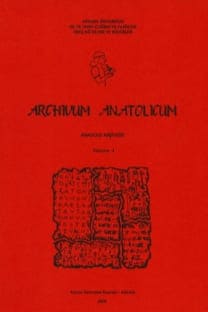Hatti’de Yabancı Tanrılar. Hatti’ye Bir Babil TanrısınınGetirilmesi ve KUB 5.6 Fal Metnine Göre Kültünün UyarlanmasıSırasında Karşılaşılan Güçlükler
Hatti’de Yabancı Tanrılar. Hatti’ye Bir Babil Tanrısının Getirilmesi ve KUB 5.6 Fal Metnine Göre Kültünün Uyarlanması Sırasında Karşılaşılan Güçlükler Sayıları binleri bulan Hitit tanrılarının pek çoğu yabancı kökenliydi ve Anadolu ile Mezopotamya kültürlerinden alınmıştı. Kim olduğu doğru dürüst bilinmeyen yabancı bir tanrının Hitit panteonuna aktarılması, yalnızca ona Åattuša’da bir tapınak yapıp bir rahip atamakla bitmiyordu. Aşırı derecede dogmatik olan dinde, ilgili tanrının kült, ayin ve bayramlarının da iyice öğrenilip, hiçbir değişiklik yapmadan uygulaması gerekirdi. Şimdiye kadar yapılan araştırmalarda Hititolojide artık bir hastalık derecesine ulaşan Aååiyawa ve güya Hitit metinlerinde geçen Mykenli “Grekler”le ilgili olarak değerlendirilen uzunca içerikli KUB 5.6 fal metninin ana teması aslında Hitit kralının aniden hastalanması dolayısıyla Kuzey Suriye’deki Aštata bölgesinden apar topar Hatti’ye getirilen bir ilahın Hitit panteonu içine entegre edilmesi sırasında karşılaşılan güçlüklerle ilgilidir. Bu entegrasyon Hititli büyücülerin o tanrının ilahi gücünden yararlanabilmeleri için mutlaka gerekliydi. İncelemede bu güçlüklerin neler olduğu açıklanmış, Suriye’den hakiki rahipler getirilinceye kadar Hititli rahiplerin ayinleri nasıl acemice yapmaya uğraştıkları anlatılmış, KUB 5.6 fal metni ilk kez tam transkripsiyon ve çevirisi verilerek ve analizi yapılarak incelenmiştir. Ayrıca metnin Aååiyawa konusunda verdiği bilgilerin ne kadar yetersiz olduğu da anlaşılacaktır
Anahtar Kelimeler:
Eski Anadolu, Hititler, din, fal, falcılık, tanrılar, yabancı tanrıların Hitit panteonuna uyarlanması, Hitit kralının hastalığı, tıp, büyü, Aååiyawa
Foreign Deities in Hatti. Transportation of a Babylonian Deity toHatti and Difficulties Encountered During Establishment of hisCult According to the Oracle Text KUB 5.6
Foreign Deities in Hatti. Transportation of a Babylonian Deity to Hatti and Difficulties Encountered During Establishment of his Cult According to the Oracle Text KUB 5.6 The majority of the one thousand Hittite deities has been borrowed or inherited from foreign cultures in Anatolia and Mesopotamia. But what were the methods of adaptation and the minute steps taken thereby? The mechanical transportation of the statue of an alien god did not only consist in erecting a temple at Åattuša and the appointment of a priest. It was necessary to study precisely the cultic instructions, rituals and festivals of the deity concerned and practice them meticulously, if one wanted the deity to meet the requirements. The oracle text KUB 5.6 helps us a great deal in understanding many of these points. The text’s main concern is with the sickness of the Hittite king, and, in accordance with the results of complicated oracular investigations, with the hasty introduction of an unknown North Syrian deity from Aštata to help the king to recover. In the face of the seriousness of his majesty’s disease the deity had to be transported as fast as possible to Hatti without any precautions and tremendous efforts were expended on his integration into the official pantheon, so that the Hittite exorcists could make full usage of him. Curiously, the importance of this text has been up to now generally limited to a thorny question in Hittitology, i.e. Aååiyawa and allegedly Myceanaean “Greeks” in the Hittite texts. This study will show clearly the nature of the difficulties Hittite experts encountered during the execution of the “curious” foreign rites, which were previously unknown to them, and how they fetched the genuine experts of the deity from Syria; moreover the study gives a full transcription and translation of the text alongside a brief linguistic commentary. It will also be evident how minor the information the text gives on Aååiyawa is within the entire context of the text
Keywords:
Ancient Anatolia, Hittites, religion, oracle, divination, adoption of foreign deities into Hittite pantheon, illness of Hittite king, medicine, exorcism, Aååiyawa,
___
- ---
- ISSN: 1300-6355
- Yayın Aralığı: Yılda 2 Sayı
- Başlangıç: 1995
- Yayıncı: Ankara Üniversitesi
Sayıdaki Diğer Makaleler
Kültepe’den Nikka İlgili Altı Yeni Belge
